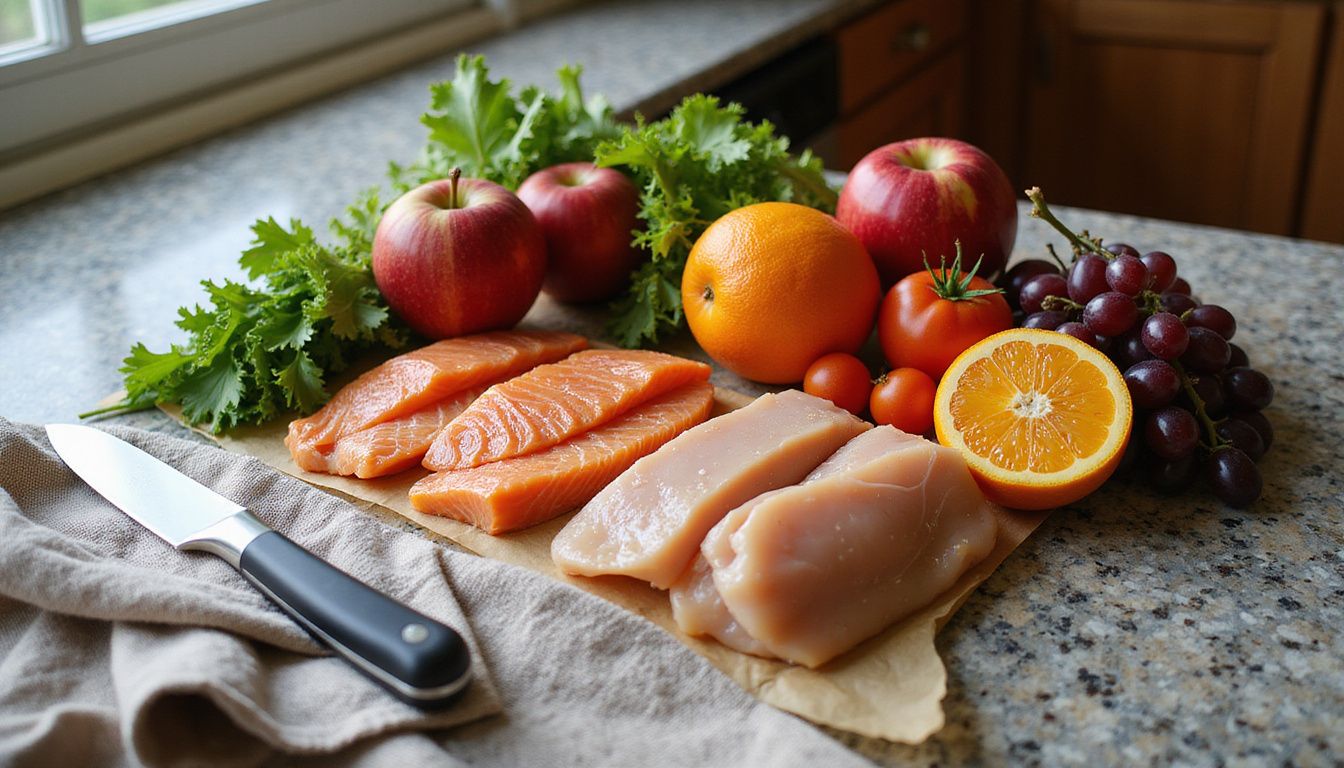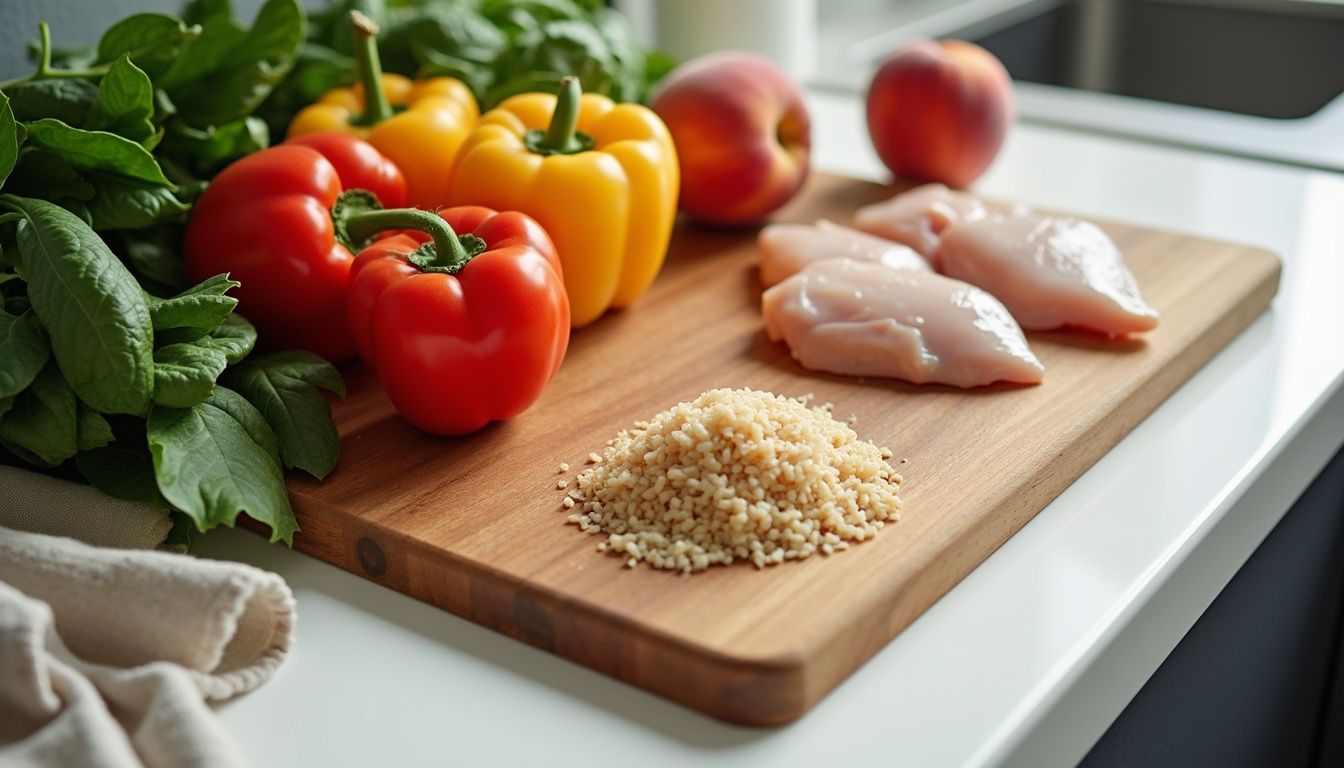7-Day Quick Weight Loss Diet Plan: Lose Weight With This Meal Plan!
Our Nutrition Assistant AI Suite will transform your body. You will lose fat, get toned, and build muscle. Gain confidence and optimal health.
If you keep stalling on weight loss, a short, structured plan can reset your routine. A Quick Weight Loss Diet Plan uses calorie goals and simple meal prep so you can lose weight safely in one focused week. This guide explains how a 7-day meal plan works, what to eat each day, and how to build habits that last.
You will see clear menus, practical tips, and notes on safety. Use what fits your life, then adjust as needed with your healthcare team.
Key Takeaways
- The 7-Day Quick Weight Loss Diet Plan averages about 1,200 calories per day, pairing calorie restriction with balanced meals to support rapid progress.
- Very low-calorie diets, or VLCDs, can lead to losses of three to five pounds per week, but they require medical supervision for safety.
- Core ideas include limiting added sugars, focusing on lean proteins and whole grains, enjoying plenty of fruits and vegetables, and trying time-restricted eating like a 16:8 schedule.
- This plan borrows methods from programs such as the Mayo Clinic Diet and is not for children, teens, pregnant people, or older adults unless a doctor approves.
- Structured menus and tracking help adults build lasting habits, lower health risks linked to obesity such as type 2 diabetes, and support long-term success.
How does the 7-Day Quick Weight Loss Diet Plan work?

Structured eating removes guesswork. This plan sets a simple daily target near 1,200 calories and centers each plate on produce, lean protein, and whole grains. Dietitians such as Stefani Sassos, MS, RD, recommend this approach because it controls calories while keeping you full.
You can scale portions with extra vegetables or fruit, and you can raise protein at a meal when you need more energy. The framework draws from programs like the Mayo Clinic Diet. It is not intended for kids, teens, pregnancy, or older adults unless your clinician clears it.
On a similar low-calorie week, I felt lighter and less bloated, mostly from cutting processed food and planning meals in advance. A clear plan during breakfast, lunch, dinner, and snacks helps you follow through.
“Healthy routines make tough transitions easier,” shares Stefani Sassos on building new habits.
The plan lays out each day’s choices so the next step is obvious. That structure reduces stress and keeps you moving toward your goal.
Key principles of the diet plan
These principles support safe weight loss and better health. They help you manage calories while protecting nutrition and lowering risks tied to obesity and type 2 diabetes.
What is calorie restriction and why is it important?
Calorie restriction means eating fewer calories than your body needs to maintain its current weight. Here, the target is about 1,200 calories per day for most adults.
This creates an energy gap so your body uses stored fat for fuel. VLCDs, which can be as low as 800 calories per day, may lead to three to five pounds lost per week under medical care only. A Low-Calorie Diet, or LCD, is safer for most people. Women often aim for 1,200 to 1,500 calories, and men for 1,500 to 1,800.
Steady calorie control usually leads to about half a pound to one pound per week over time. That pace is safer, supports daily energy, and lowers the chance of rebound weight gain.
When I followed an LCD built on whole grains and lean proteins, I lost inches while keeping energy stable across the week.
How to balance macronutrients effectively?
Macronutrients include protein, carbohydrates, and fat. Aim for a plate with lean protein, whole grains, and healthy fats. Examples include chicken breast or tuna for protein, quinoa or oatmeal for carbs, and nuts or nut butter for healthy fat.
Fruits and vegetables add fiber, which helps you feel full on fewer calories. A common plate guide works well: half fruits and vegetables, one quarter lean protein, one quarter whole grains. Diets rich in fiber from beans, nuts, fish, whole grains, and produce are linked with a lower risk of cardiovascular disease and stroke.
A balanced plate is key: half fruits and vegetables, one quarter lean protein, one quarter whole grains.
Keep portions reasonable so you can lose about one to two pounds per week. Choose nutrient-dense foods rather than fad diets or heavy reliance on meal replacements.
What is time-restricted eating and how does it help?
Time-restricted eating limits the hours you eat each day. A common pattern is 16:8, which means you eat within any eight-hour window, such as 10 a.m. to 6 p.m. It is a form of intermittent fasting that organizes “when” you eat rather than only “how much.”
Studies link time-restricted eating with weight loss, better insulin sensitivity, and less body fat. Some people mix schedules such as 5:2, where two days per week are very low in calories. Many also find that stopping late-night snacks reduces cravings and keeps habits consistent.
What are the benefits of the 7-Day Diet Plan?
This plan gives you structure and simple menus. It can jump-start weight loss, then guide you toward steady, healthy eating.
How does this plan promote rapid weight loss?
Daily calories stay near 1,200, which pushes your body to use stored fat. Research on VLCDs shows possible losses of three to five pounds per week under medical care. In the LOSE IT! phase of programs like the Mayo Clinic Diet, many see six to ten pounds in two weeks.
Balanced meals that include lean protein, produce, and whole grains raise nutrition while staying low in calories. Simple choices like yogurt or cottage cheese can also stand in for a meal when time is tight.
A friend who tried a similar plan saw early results by day three, which made it easier to stay motivated. Quick progress in week one often builds momentum for long-term change.
Can it improve metabolism?
Metabolism is the way your body turns food into energy. Time-restricted eating may help regulate your metabolic rate by creating a steady rhythm for meals. Research suggests better insulin sensitivity and glucose control in people with obesity or diabetes who follow structured meal timing.
High-fiber foods also support digestion and may improve how efficiently your body uses energy. After a fast loss phase, the LIVE IT! phase focuses on steady calories to support long-term metabolic health.
How does it enhance energy levels?
Steady meals with lean protein, whole grains, and plenty of produce help keep blood sugar stable. That reduces mid-afternoon crashes. Swapping sugary snacks for fruit or nuts supports consistent energy.
Short daily exercise sessions can lift your mood and alertness. Hydrating foods and fluids, such as soups and water, also help you feel more awake. On this plan, many people report clearer focus once they settle into a routine.
How does it support healthy eating habits?
The plan uses behavior-change tools that teach you to drop unhelpful habits and add better ones. It encourages generous servings of fruits and vegetables, smart portions, and simple tracking for awareness.
Using a food log and a weight tracker can keep you honest and reduce mindless eating. When I logged meals last year, I made fewer impulse choices and picked yogurt or salads instead of candy or chips.
This method can reduce risk factors linked to heart disease, type 2 diabetes, sleep apnea, kidney disease, and obesity, while helping you maintain a healthy weight.
Sample 7-Day Meal Plan
This sample plan offers easy, tasty ideas. Meals are nutrient dense, lower in calories, and simple to prepare.
Day 1:
Day 1 sets the tone with balanced, low-calorie meals near 1,200 calories.
- Eat breakfast with 3/4 cup bran flakes, 1 banana, and 1 cup fat-free milk for fiber, vitamins, and protein.
- For a morning snack, choose a medium apple or 1 cup sliced peppers. Keep snacks under 75 calories.
- Lunch includes a turkey pita sandwich, mozzarella string cheese, and two kiwis for lean protein and fiber.
- Snack on a small handful of nuts or fruit later to steady energy between meals.
- Dinner features 4 ounces flounder, 1 cup couscous, and steamed broccoli. Add one small ice cream portion under 75 calories.
- Drink water instead of sugary drinks to support metabolism and hydration.
- Keep daily calories near 1,200 as suggested by many patient guides.
- Balance each meal with lean protein, whole grains, and produce to support fullness and energy.
- Avoid weight loss supplements unless your healthcare provider approves them.
Structured menus helped me stay consistent and lose weight at a safe pace. Regular meal times and simple foods made the plan easier to follow.
What should I eat for breakfast on Day 1?
Start with 3/4 cup bran flakes, one banana, and a cup of fat-free milk. You get whole grains for energy, fruit for vitamins, and dairy for protein with little added sugar.
High-fiber breakfasts are linked with better weight control in adults. This meal supports a 1,200-calorie day and may help manage blood pressure and lower risks tied to type 2 diabetes.
On similar plans, I felt fuller through the morning, which made it easier to keep calories in range.
What is a healthy lunch option for Day 1?
Choose a turkey pita sandwich for lunch. It pairs lean deli turkey with whole grain pita for protein and complex carbs. Add a mozzarella string cheese for extra protein and calcium, plus two kiwis for fiber and vitamin C.
This lunch fits a 1,200-calorie day and supports fullness. You get protein and produce together, which helps with steady energy and fewer cravings.
What is a good dinner choice for Day 1?
Pick 4 ounces of flounder, 1 cup couscous, and 1 cup broccoli. You get lean protein, whole grains, and fiber-rich vegetables. A small ice cream serving can fit your calories.
This lineup supports a low-fat pattern that favors heart health. When I ate this way on day one, I felt satisfied without feeling heavy.
Day 2:
Day 2 continues calorie control with lean proteins and high-fiber sides. Aim to stay close to 1,200 calories.
- Start breakfast with a berry banana smoothie and two hard-boiled eggs for protein and fiber.
- For lunch, have a vegetable soup with a veggie burger and grapes. Fiber supports steady blood glucose.
- Dinner includes BBQ cutlets with citrus slaw and half a potato for balance and steady energy.
- Keep daily calories near 1,200 to support rapid progress for adults with overweight or obesity.
- Choose fresh fruit or raw vegetables as snacks if needed between meals.
- Follow portion control at each meal to avoid excess calories.
- Drink water instead of sugary beverages to support metabolism.
- Add light activity like walking or home routines to enhance results.
- People with diabetes or significant health concerns should ask their clinician before trying restrictive days like this.
- Stay mindful of choices. Small, consistent steps add up across the week.
What should I eat for breakfast on Day 2?
Blend one banana with half a cup of berries and water or unsweetened almond milk for a smoothie. Add one or two hard-boiled eggs for protein.
This mix fits your calorie goals and balances healthy carbs with protein. High-fiber fruit at breakfast may also lower your risk of type 2 diabetes over time.
What is a healthy lunch option for Day 2?
Choose a bowl of vegetable soup and a veggie burger for plant-based protein. Add a cup of grapes for natural sweetness and vitamins.
This lunch is portion-controlled and high in fiber, which supports fullness and reduces mid-afternoon dips. During recovery after bariatric surgery, I found veggie burgers and hearty soups very satisfying without feeling deprived.
What is a good dinner choice for Day 2?
BBQ cutlets with citrus slaw and half a potato make a balanced dinner. You get lean protein, produce, and a moderate starch portion.
The slaw brings fiber and vitamin C without added sugar. Meals like this help people stick to low-calorie plans because they are satisfying^1^. Whole foods also improve nutrient intake compared with many processed options^2^.
…
Day 3:
Day 3 offers fiber, lean protein, and whole grains with focused calorie control.
- Start with oatmeal topped with chopped apple and a light drizzle of honey for slow-release energy.
- For lunch, make chicken salad with greens, tomato, cucumber, and light vinaigrette. Add one slice of multigrain toast.
- Dinner includes 4 ounces shrimp in olive oil, one baked potato with salsa and plain yogurt, three cups steamed spinach, and a small chocolate or ice cream bar.
- Keep snacks portioned. A handful of almonds or walnuts can curb hunger without too many calories.
- Stay around 1,200 calories for the day to support steady weight loss.
- Drink water instead of soda to cut extra calories and stay hydrated.
- Following this structure builds a routine that supports long-term habits.
When I shifted my snacks from chips to nuts, my energy improved within three days and cravings dropped.
What should I eat for breakfast on Day 3?
Have oatmeal topped with half an apple, chopped, and half a tablespoon of honey. Whole grains and fruit raise fiber and help you feel full longer.
Measure each ingredient. This meal supports calorie control and a steady morning.
What is a healthy lunch option for Day 3?
Pick chicken salad with multigrain toast. You get lean protein plus whole grains for stable energy. The portion supports your daily calorie target and helps fight afternoon cravings.
What is a good dinner choice for Day 3?
Serve 4 ounces of shrimp with a baked potato topped with salsa and low-fat yogurt. Add three cups of steamed spinach for fiber and minerals.
This dinner fits a 1,200-calorie day and includes a small dessert so you can enjoy a treat without going off plan. Allowing a small sweet helped me avoid nighttime snacking.
Day 4:
Day 4 keeps calories near 1,200 with meals that feel fresh and satisfying.
- Start with Greek yogurt topped with berries. Expect around 15 grams of protein.
- For lunch, have tomato soup with a roast beef pita, mixed veggies, and two tablespoons hummus.
- Dinner features 4 ounces poached salmon, a crunchy slaw, and 1 cup quinoa.
- Snack on half an apple or a handful of almonds if hunger hits between meals.
- Drink at least eight cups of water to manage appetite and support metabolism.
- Try an 8 to 10 hour eating window to help regulate blood sugar.
- Each meal balances protein, fiber, and healthy fats to protect muscle during calorie control.
This pattern earns quick wins while keeping nutrition solid.
What should I eat for breakfast on Day 4?
Eat a serving of plain Greek yogurt with mixed berries. You get protein, antioxidants, and a manageable calorie load, typically under 200.
Protein at breakfast can reduce cravings later, which makes it easier to meet your goals.
What is a healthy lunch option for Day 4?
Pair tomato soup with a roast beef pita. Add crisp vegetables and hummus. This meal combines hydration, protein, fiber, and healthy fats while staying within a 1,200-calorie target.
Meals like this kept me full and clear-headed through the afternoon.
What is a good dinner choice for Day 4?
Choose 4 ounces of poached salmon with slaw and 1 cup quinoa. Salmon supplies omega-3 fats that support heart health. Quinoa adds complex carbs and fiber.
The portions keep calories in check and show what a balanced plate looks like on this plan.
Day 5:
Day 5 offers variety to prevent boredom while keeping calories controlled.
- Start breakfast with Cheerios, berries, and a dollop of Greek yogurt. Add a small handful of almonds for healthy fat and crunch.
- Choose fresh fruit like an apple or orange for a mid-morning snack, and sip water.
- For lunch, make mushroom quesadillas with whole-wheat tortillas. Add cucumber slices, cottage cheese, and two clementines.
- Allow one sweet treat under 75 calories, such as a square of dark chocolate.
- Pick balsamic-glazed pork for dinner with roasted butternut squash to stay within 1,200 calories.
- Keep snacks light, like baby carrots or cherry tomatoes, if you are hungry after dinner.
- When I followed this layout last fall, variety kept me engaged and I lost four pounds in a week.
- Measure portions so you do not exceed your daily target.
- If you are pregnant, check with a clinician before using restrictive plans.
What should I eat for breakfast on Day 5?
Have a portion-controlled bowl of Cheerios topped with fresh berries and a sprinkle of almonds. Add one serving of Greek yogurt on the side for extra protein.
This mix of whole grains, fruit, healthy fat, and dairy protein supports steady morning energy and fits your calorie plan.
What is a healthy lunch option for Day 5?
Choose mushroom quesadillas with a side of cucumber, cottage cheese, and two clementines. You get dairy protein, fiber, and vitamin C while keeping lunch under 400 calories.
I felt energized into the afternoon with this combination. It filled me up without feeling heavy.
What is a good dinner choice for Day 5?
Balsamic-glazed pork makes a flavorful, lean protein. Serve it with roasted butternut squash for fiber and steady carbs.
This dinner fits the plan’s nutrition targets and may help prevent late-night cravings. Pairing lean protein with vegetables supports energy and metabolism through the week.
Day 6:
Day 6 focuses on balance, variety, and smart portions.
- Eat a whole-grain waffle with nut butter and banana slices for breakfast. Add a cup of low-fat milk.
- Make a tuna salad with greens and celery for lunch. Add carrot sticks, Greek yogurt, and a fresh pear.
- For dinner, prepare sausage jambalaya with lean sausage, brown rice, tomatoes, and bell peppers. Serve with sautéed spinach.
- Snack on fruit or raw vegetables between meals if hungry.
- Keep sweets small so calories stay near 1,200.
- Drink at least eight cups of water. Unsweetened tea is fine.
- Eat within a set window each day to support your routine.
What should I eat for breakfast on Day 6?
Choose a whole-grain waffle topped with nut butter and banana. Drink a glass of milk for protein and calcium.
This breakfast offers complex carbs, healthy fats, fruit, and dairy to keep you full and on track.
What is a healthy lunch option for Day 6?
Make tuna salad with water-packed tuna, chopped celery, and light mayo. Add carrot sticks for crunch, Greek yogurt for protein and probiotics, and a fresh pear for fiber.
Lean fish protein keeps you full. Produce and dairy round out the nutrients while keeping calories controlled.
What is a good dinner choice for Day 6?
Sausage jambalaya with sautéed spinach is a balanced option. Lean sausage provides protein, brown rice adds complex carbs, and spinach supplies iron and vitamins.
Portion-controlled meals like this help you manage calories without sacrificing flavor. Including leafy greens boosts nutrients with very few calories[1].
…
Day 7:
Day 7 keeps you focused with whole foods and simple prep. Calories stay close to 1,200 while you finish strong.
- Breakfast: an English muffin with cheese, tomato, spinach, and a poached egg. Add half a grapefruit.
- Lunch: a black bean salad with corn tortillas and fresh fruit for plant-based protein and steady carbs.
- Dinner: roasted vegetables with grilled chicken or tofu. Add brown rice or quinoa.
- Snacks: carrot sticks or low-fat yogurt if needed to control hunger.
- Drink water through the day instead of high-calorie drinks.
- Keep portions reasonable at each meal. Smaller plates can help.
- Load your plate with colorful produce for antioxidants and satisfaction.
- Limit dessert to one small piece of dark chocolate or fruit.
- Use herbs and spices for flavor, not extra butter or heavy sauces.
- End the day knowing your choices built momentum in one week.
What should I eat for breakfast on Day 7?
Top a whole-grain English muffin with cheese, tomato slices, and wilted spinach. Add a poached egg for protein. Serve half a grapefruit on the side.
This breakfast covers all major food groups and supports energy until lunch. I stayed full on mornings like this while following the plan.
What is a healthy lunch option for Day 7?
Pick a black bean salad with a small whole grain tortilla and fresh fruit. Beans provide plant-based protein and fiber that help you feel full.
Top the salad with tomatoes, cilantro, corn, and lime juice for flavor without extra calories. A cup of mixed fruit, such as berries or an apple, adds vitamins and natural sweetness. Studies suggest high-fiber lunches can support appetite control through the afternoon (Mayer et al., 2017).
What is a good dinner choice for Day 7?
Grilled salmon with steamed broccoli and a half-cup of cooked quinoa makes an excellent dinner. Salmon supports muscle during weight loss. Broccoli adds fiber and vitamins. Quinoa gives steady energy from complex carbs.
For variety, add roasted peppers or a side salad. Use olive oil lightly to keep calories in range. This pattern of lean protein, vegetables, and whole grains mirrors the plan’s approach at every dinner.
How does exercise maximize weight loss results?
Exercise helps protect muscle while you cut calories. Try walking or cycling for at least 30 minutes each day. If you are new to activity, start small and increase over time so you can stick with it.
Movement also supports long-term results after the 7-day plan. During my own quick reset, short daily walks raised my energy and helped keep muscle while I followed a lower-calorie menu.
Check with a healthcare provider before starting a new workout, especially if you have medical conditions or concerns about safety.
What health concerns and precautions should I consider?
Some people feel side effects during a 7-day quick weight loss plan. Review safety basics and talk with a clinician if you have any ongoing health issues.
Why should I consult a healthcare professional before starting?
A clinician can confirm if a 7-day quick plan is safe for you, especially with diabetes, high blood pressure, or other conditions. Rapid calorie cuts can stress your body and may lead to fast regain if the plan does not fit your needs.
Medical guidance helps you meet nutrient needs and manage side effects. Do not start this plan without expert advice if you are under 18, pregnant, older, or managing chronic illness. My doctor adjusted a fast-track week to match my medication schedule and monitored my progress.
What are the risks of overly restrictive calorie intake?
Severe restriction can reduce muscle, water, and even bone mass. It raises the risk of fatigue, constipation, diarrhea, nausea, gallstones, and gout. Losing more than 1 to 2 pounds per week is usually unsafe for most people.
Long stretches of extreme diets can disrupt normal body functions and often lead to rebound weight gain. Children, teens, older adults, pregnant people, and those with medical conditions face higher risks without close supervision.
What tips can help with long-term weight loss success?
Short plans can start progress, but habits keep it going. Use these steps to maintain results after the week ends.
How to gradually increase calorie intake after dieting?
Increase calories in small steps. Add 50 to 100 calories per day for a week, then check your weight and energy. If your weight holds steady, add another small step the next week.
Pick healthy foods such as berries, nuts, vegetables, whole grains, and lean proteins. Track changes with a food log or app. Keep moving with 30 minutes of activity on most days so gains in calories match gains in output.
How to maintain healthy eating habits long-term?
Choose lean protein and fiber-rich produce at every meal. Use smaller plates or measure servings to control portions. Prep meals on weekends to make weeknights easier.
Swap high-calorie snacks for nuts, yogurt, or fruit. Planning on Sundays helped me skip takeout after work. If you have medical needs or allergies, ask your healthcare provider for guidance that fits you.
Why is staying physically active important?
Healthy eating sets the base, and daily activity makes your results stronger. Regular exercise helps manage weight and lowers the risk of diabetes and heart disease.
Aim for at least 30 minutes of movement each day. Brisk walking, biking, or swimming all count. Combine portion control with a high intake of fruits and vegetables for steady progress.
Conclusion
A 7-day quick weight loss diet plan can jump-start your healthy routine. It blends calorie restriction, balanced meals, and simple time-restricted eating for early progress. Many adults with obesity see short-term benefits from structured plans, especially when paired with activity and tracking.
Check with your healthcare provider before making major changes. Use this sample plan as a starting point, then adapt it to fit your life. Small, steady habits lead to lasting results.
…
[1] Mayo Clinic Staff. (2022). “Mayo Clinic Diet: A weight-loss program for life.” MayoClinic.org.
[1] Harvard T.H. Chan School of Public Health: “Vegetables and Fruits”, 2022.
^1: Obesity and the Environment, Endocrinology Health System Report (2023)
^2: Social Determinants of Health & Diet Quality Study (2022)
FAQs
1. What is the main goal of a 7-day quick weight loss diet plan?
The primary aim of this meal plan is to help individuals reduce body fat in one week through structured eating patterns and controlled calorie intake. Studies show that short-term, calorie-restricted diets can lead to measurable weight reduction when paired with regular activity and hydration.
2. Are there any risks linked to following a rapid weight loss meal plan for seven days?
Short-term plans may cause fatigue, headaches, or nutrient gaps if not carefully designed. Research from the Academy of Nutrition and Dietetics suggests monitoring your health closely during such programs; consult a registered dietitian before starting.
3. What foods are included in this 7-day meal plan for effective results?
This program features lean proteins like chicken breast or tofu, whole grains such as brown rice or oats, fresh produce including spinach and berries, plus healthy fats from sources like olive oil or avocado. A sample day might provide about 1,200–1,500 calories with balanced macronutrients.
4. Can someone maintain their results after completing the seven-day quick weight loss diet?
Maintaining progress depends on adopting long-term habits after finishing the initial phase. Evidence indicates that gradual lifestyle changes—such as consistent portion control and daily movement—support lasting success more than repeated short cycles alone.
Summary: The 7-day quick weight loss diet focuses on reducing calories while providing essential nutrients through specific food choices over one week. Monitoring health status is important due to potential side effects; professional guidance increases safety and effectiveness. Sustainable habits formed during this period improve chances for ongoing healthy living beyond the first week.







